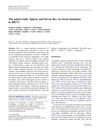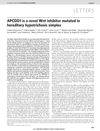42 citations
,
July 2015 in “PLoS ONE” The study provided the first three-dimensional structural models of the complete epithelial human K1/K10 keratin dimer, revealing insights into the tri-domain structure consisting of the head, rod, and tail. It highlighted the chirality of the rod-domain twist and identified tri-subdomain partitioning in the head and tail domains. Additionally, the research identified residue characteristics that mediate non-covalent contact between chains in the dimer. These findings were significant for understanding the molecular-level connections between structure and function in intermediate filament proteins and were applicable to other epithelial keratins and intermediate filament proteins.
29 citations
,
July 2015 in “Journal of Medical Genetics” The study investigated woolly hair (WH) in two consanguineous Pakistani families and identified a homozygous missense variant c.950T>C (p.(Leu317Pro)) in the KRT25 gene as the cause of autosomal recessive WH. This variant was found to disrupt the protein structure, potentially affecting the interaction with type II keratins in the hair follicle, leading to the characteristic tightly curled hair. The findings highlighted a novel gene involved in hair abnormalities and supported the role of type I keratins in hair follicle development and hair texture maintenance.
21 citations
,
April 2014 in “PLoS ONE” The study investigated a consanguineous Pakistani family with autosomal recessive pure hair and nail ectodermal dysplasia (AR PHNED) and identified a rare homozygous c.821T>C variant (p.Phe274Ser) in the KRT74 gene. This mutation, which affects the stability of keratin intermediate filaments, was linked to the condition in the family, as confirmed by immunohistochemical analyses showing loss of Keratin-74 expression in affected individuals. This was the first time a KRT74 missense variant was associated with AR PHNED, expanding the known phenotypic spectrum of KRT74 mutations, which were previously linked to autosomal dominant woolly hair/hypotrichosis simplex (ADWH).
39 citations
,
December 2012 in “The American Journal of Human Genetics” 78 citations
,
May 2012 in “Journal of Investigative Dermatology” 40 citations
,
December 2010 in “Human Genetics”  75 citations
,
October 2010 in “Mammalian genome”
75 citations
,
October 2010 in “Mammalian genome” Sphynx cats are hairless and Devon Rex cats have curly hair due to specific genetic mutations.
11 citations
,
July 2010 in “European Journal of Dermatology”  199 citations
,
April 2010 in “Nature”
199 citations
,
April 2010 in “Nature” A gene called APCDD1, which controls hair growth, is found to be faulty in a type of hair loss called hereditary hypotrichosis simplex.
97 citations
,
March 2010 in “The American Journal of Human Genetics” 45 citations
,
January 2010 in “Journal of Veterinary Medical Science” 189 citations
,
July 2009 in “The Journal of clinical investigation/The journal of clinical investigation” Epidermolysis bullosa simplex causes easily blistered skin due to faulty skin cell proteins, leading to new treatment ideas.
1398 citations
,
May 2008 in “Histochemistry and Cell Biology” 210 citations
,
February 2008 in “Nature genetics” Mutations in the P2RY5 gene cause autosomal recessive woolly hair.
27 citations
,
November 2007 in “Genomics” Mutations in specific keratin genes cause improper hair structure in mice due to faulty keratin protein assembly.
138 citations
,
March 2007 in “Experimental cell research” Only a few hair-specific keratins are linked to inherited hair disorders.
51 citations
,
December 2006 in “Mammalian Genome” 194 citations
,
November 2006 in “Science” A genetic mutation in the LIPH gene causes hair loss and growth defects.
93 citations
,
July 2006 in “Journal of Investigative Dermatology” 276 citations
,
January 2005 in “International review of cytology” 53 citations
,
October 2003 in “Genetics” 42 citations
,
September 2003 in “Journal of Investigative Dermatology”


